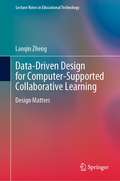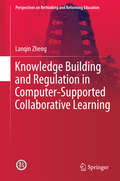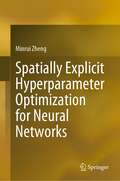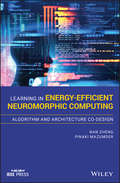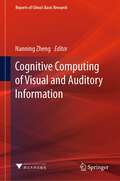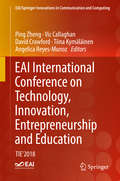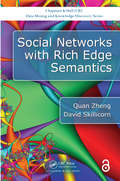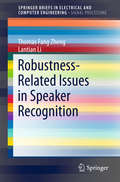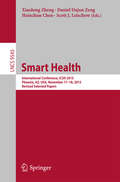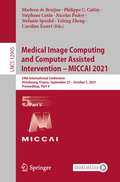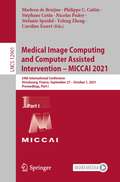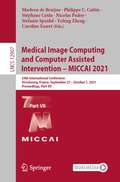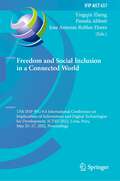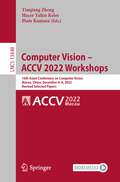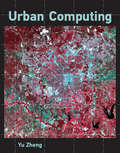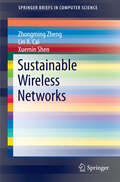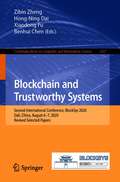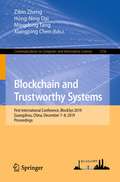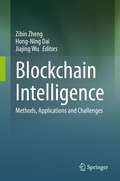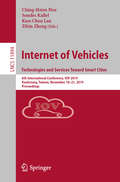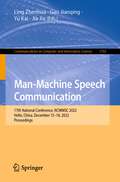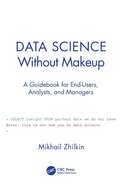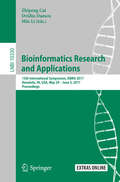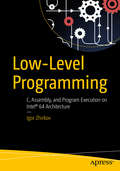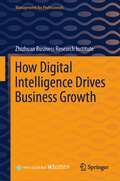- Table View
- List View
Data-Driven Design for Computer-Supported Collaborative Learning: Design Matters (Lecture Notes in Educational Technology)
by Lanqin ZhengThis book highlights the importance of design in computer-supported collaborative learning (CSCL) by proposing data-driven design and assessment. It addresses data-driven design, which focuses on the processing of data and on improving design quality based on analysis results, in three main sections. The first section explains how to design collaborative learning activities based on data-driven design approaches, while the second shares illustrative examples of computer-supported collaborative learning activities. In turn, the third and last section demonstrates how to evaluate design quality and the fidelity of enactment based on design-centered research.The book features several examples of innovative data-driven design approaches to optimizing collaborative learning activities; highlights innovative CSCL activities in authentic learning environments; demonstrates how learning analytics can be used to optimize CSCL design; and discusses the design-centered research approach to evaluating the alignment between design and enactment in CSCL. Given its scope, it will be of interest to a broad readership including researchers, educators, practitioners, and students in the field of collaborative learning, as well as the rapidly growing community of people who are interested in optimizing learning performance with CSCL.
Knowledge Building and Regulation in Computer-Supported Collaborative Learning
by Lanqin ZhengThis book proposes and validates an information flow approach to analyzing knowledge co-construction and predicting group performance in the context of collaborative learning. In addition, it highlights the importance of socially shared regulation in collaborative learning, and illustrates in detail how it can be analyzed and promoted. The book investigates several innovative examples, including: Methodological approaches to studying and analyzing knowledge building and regulation in collaborative learning; Social software tools for capturing the dynamics of knowledge building and regulation in collaborative learning; Collective regulatory mechanisms to scaffold socially shared regulation in real-life collaborative learning; and Scripts and interventions to facilitate effective and productive collaborative learning on the basis of several case studies. The original methodological contributions to the analysis of knowledge building and scaffolding socially shared regulation make this an essential read for anyone interested in collaborative learning. This book will also be of interest to a wide audience of researchers, teachers, and students in the field of collaborative learning, as well as the rapidly growing community of people investigating how collaborative learning can be effectively used in education.
Spatially Explicit Hyperparameter Optimization for Neural Networks
by Minrui ZhengNeural networks as the commonly used machine learning algorithms, such as artificial neural networks (ANNs) and convolutional neural networks (CNNs), have been extensively used in the GIScience domain to explore the nonlinear and complex geographic phenomena. However, there are a few studies that investigate the parameter settings of neural networks in GIScience. Moreover, the model performance of neural networks often depends on the parameter setting for a given dataset. Meanwhile, adjusting the parameter configuration of neural networks will increase the overall running time. Therefore, an automated approach is necessary for addressing these limitations in current studies. This book proposes an automated spatially explicit hyperparameter optimization approach to identify optimal or near-optimal parameter settings for neural networks in the GIScience field. Also, the approach improves the computing performance at both model and computing levels. This book is written for researchers of the GIScience field as well as social science subjects.
Learning in Energy-Efficient Neuromorphic Computing: Algorithm And Architecture Co-design (Wiley - IEEE)
by Nan Zheng Pinaki MazumderExplains current co-design and co-optimization methodologies for building hardware neural networks and algorithms for machine learning applications This book focuses on how to build energy-efficient hardware for neural networks with learning capabilities—and provides co-design and co-optimization methodologies for building hardware neural networks that can learn. Presenting a complete picture from high-level algorithm to low-level implementation details, Learning in Energy-Efficient Neuromorphic Computing: Algorithm and Architecture Co-Design also covers many fundamentals and essentials in neural networks (e.g., deep learning), as well as hardware implementation of neural networks. The book begins with an overview of neural networks. It then discusses algorithms for utilizing and training rate-based artificial neural networks. Next comes an introduction to various options for executing neural networks, ranging from general-purpose processors to specialized hardware, from digital accelerator to analog accelerator. A design example on building energy-efficient accelerator for adaptive dynamic programming with neural networks is also presented. An examination of fundamental concepts and popular learning algorithms for spiking neural networks follows that, along with a look at the hardware for spiking neural networks. Then comes a chapter offering readers three design examples (two of which are based on conventional CMOS, and one on emerging nanotechnology) to implement the learning algorithm found in the previous chapter. The book concludes with an outlook on the future of neural network hardware. Includes cross-layer survey of hardware accelerators for neuromorphic algorithms Covers the co-design of architecture and algorithms with emerging devices for much-improved computing efficiency Focuses on the co-design of algorithms and hardware, which is especially critical for using emerging devices, such as traditional memristors or diffusive memristors, for neuromorphic computing Learning in Energy-Efficient Neuromorphic Computing: Algorithm and Architecture Co-Design is an ideal resource for researchers, scientists, software engineers, and hardware engineers dealing with the ever-increasing requirement on power consumption and response time. It is also excellent for teaching and training undergraduate and graduate students about the latest generation neural networks with powerful learning capabilities.
Cognitive Computing of Visual and Auditory Information (Reports of China’s Basic Research)
by Nanning ZhengThis book discusses fruitful achievements in basic cognitive theories, processing technologies of visual and auditory information and research platforms. This book also can provide strong support for the research and development of artificial intelligence of major national projects, playing important roles in national application systems such as unmanned systems and smart cities. In addition, it has laid a solid foundation for the development of artificial intelligence in China. Intended for researchers who have been following the evolution of and trends in the artificial intelligence, the book is also a valuable reference resource for practitioners and scholars at various levels and in various fields.
EAI International Conference on Technology, Innovation, Entrepreneurship and Education: TIE'2018 (Lecture Notes in Electrical Engineering #532)
by Ping Zheng Vic Callaghan David Crawford Tiina Kymäläinen Angelica Reyes-MunozThis book presents the proceedings of the 2nd EAI International Conference on Technology, Innovation, Entrepreneurship and Education (TIE' 2018), which took place at Ravensbourne University London, London, UK, on September 4, 2018. The central theme of the conference is emerging technologies in relation to business, education, social and political needs that make modern society flourish. The proceedings feature papers from a cross-disciplinary audience that explore the process of creativity and innovation. The goal is that the various disciplines can learn from each other and see how they might benefit from the cross-fertilization of practices.
Social Networks with Rich Edge Semantics (Chapman & Hall/CRC Data Mining and Knowledge Discovery Series)
by Quan Zheng David SkillicornSocial Networks with Rich Edge Semantics introduces a new mechanism for representing social networks in which pairwise relationships can be drawn from a range of realistic possibilities, including different types of relationships, different strengths in the directions of a pair, positive and negative relationships, and relationships whose intensities change with time. For each possibility, the book shows how to model the social network using spectral embedding. It also shows how to compose the techniques so that multiple edge semantics can be modeled together, and the modeling techniques are then applied to a range of datasets. Features Introduces the reader to difficulties with current social network analysis, and the need for richer representations of relationships among nodes, including accounting for intensity, direction, type, positive/negative, and changing intensities over time Presents a novel mechanism to allow social networks with qualitatively different kinds of relationships to be described and analyzed Includes extensions to the important technique of spectral embedding, shows that they are mathematically well motivated and proves that their results are appropriate Shows how to exploit embeddings to understand structures within social networks, including subgroups, positional significance, link or edge prediction, consistency of role in different contexts, and net flow of properties through a node Illustrates the use of the approach for real-world problems for online social networks, criminal and drug smuggling networks, and networks where the nodes are themselves groups Suitable for researchers and students in social network research, data science, statistical learning, and related areas, this book will help to provide a deeper understanding of real-world social networks.
Robustness-Related Issues in Speaker Recognition
by Thomas Fang Zheng Lantian LiThis book presents an overview of speaker recognition technologies with an emphasis on dealing with robustness issues. Firstly, the book gives an overview of speaker recognition, such as the basic system framework, categories under different criteria, performance evaluation and its development history. Secondly, with regard to robustness issues, the book presents three categories, including environment-related issues, speaker-related issues and application-oriented issues. For each category, the book describes the current hot topics, existing technologies, and potential research focuses in the future. The book is a useful reference book and self-learning guide for early researchers working in the field of robust speech recognition.
Smart Health
by Xiaolong Zheng Daniel Dajun Zeng Hsinchun Chen Scott J. LeischowThis book constitutes the thoroughly refereedpost-conference proceedings of the International Conference for Smart Health,ICSH 2015, held in Phoenix, AZ, USA, in November 2015. The 33 papers presented together were carefully reviewedand selected from 43 submissions. The conference focused on topics and issuesincluding medical monitoring and information extraction, clinical and medicaldata mining, health data analysis and management, big data and smart health,and healthcare intelligent systems and clinical practice.
Medical Image Computing and Computer Assisted Intervention – MICCAI 2021: 24th International Conference, Strasbourg, France, September 27 – October 1, 2021, Proceedings, Part V (Lecture Notes in Computer Science #12905)
by Yefeng Zheng Stéphane Cotin Caroline Essert Stefanie Speidel Philippe C. Cattin Marleen De Bruijne Nicolas PadoyThe eight-volume set LNCS 12901, 12902, 12903, 12904, 12905, 12906, 12907, and 12908 constitutes the refereed proceedings of the 24th International Conference on Medical Image Computing and Computer-Assisted Intervention, MICCAI 2021, held in Strasbourg, France, in September/October 2021.*The 542 revised full papers presented were carefully reviewed and selected from 1809 submissions in a double-blind review process. The papers are organized in the following topical sections: Part I: image segmentation Part II: machine learning - self-supervised learning; machine learning - semi-supervised learning; and machine learning - weakly supervised learning Part III: machine learning - advances in machine learning theory; machine learning - domain adaptation; machine learning - federated learning; machine learning - interpretability / explainability; and machine learning - uncertainty Part IV: image registration; image-guided interventions and surgery; surgical data science; surgical planning and simulation; surgical skill and work flow analysis; and surgical visualization and mixed, augmented and virtual reality Part V: computer aided diagnosis; integration of imaging with non-imaging biomarkers; and outcome/disease prediction Part VI: image reconstruction; clinical applications - cardiac; and clinical applications - vascular Part VII: clinical applications - abdomen; clinical applications - breast; clinical applications - dermatology; clinical applications - fetal imaging; clinical applications - lung; clinical applications - neuroimaging - brain development; clinical applications - neuroimaging - DWI and tractography; clinical applications - neuroimaging - functional brain networks; clinical applications - neuroimaging – others; and clinical applications - oncology Part VIII: clinical applications - ophthalmology; computational (integrative) pathology; modalities - microscopy; modalities - histopathology; and modalities - ultrasound*The conference was held virtually.
Medical Image Computing and Computer Assisted Intervention – MICCAI 2021: 24th International Conference, Strasbourg, France, September 27–October 1, 2021, Proceedings, Part I (Lecture Notes in Computer Science #12901)
by Yefeng Zheng Stéphane Cotin Caroline Essert Stefanie Speidel Philippe C. Cattin Marleen De Bruijne Nicolas PadoyThe eight-volume set LNCS 12901, 12902, 12903, 12904, 12905, 12906, 12907, and 12908 constitutes the refereed proceedings of the 24th International Conference on Medical Image Computing and Computer-Assisted Intervention, MICCAI 2021, held in Strasbourg, France, in September/October 2021.*The 542 revised full papers presented were carefully reviewed and selected from 1809 submissions in a double-blind review process. The papers are organized in the following topical sections: Part I: image segmentation Part II: machine learning - self-supervised learning; machine learning - semi-supervised learning; and machine learning - weakly supervised learning Part III: machine learning - advances in machine learning theory; machine learning - domain adaptation; machine learning - federated learning; machine learning - interpretability / explainability; and machine learning - uncertainty Part IV: image registration; image-guided interventions and surgery; surgical data science; surgical planning and simulation; surgical skill and work flow analysis; and surgical visualization and mixed, augmented and virtual reality Part V: computer aided diagnosis; integration of imaging with non-imaging biomarkers; and outcome/disease prediction Part VI: image reconstruction; clinical applications - cardiac; and clinical applications - vascular Part VII: clinical applications - abdomen; clinical applications - breast; clinical applications - dermatology; clinical applications - fetal imaging; clinical applications - lung; clinical applications - neuroimaging - brain development; clinical applications - neuroimaging - DWI and tractography; clinical applications - neuroimaging - functional brain networks; clinical applications - neuroimaging – others; and clinical applications - oncology Part VIII: clinical applications - ophthalmology; computational (integrative) pathology; modalities - microscopy; modalities - histopathology; and modalities - ultrasound*The conference was held virtually.
Medical Image Computing and Computer Assisted Intervention – MICCAI 2021: 24th International Conference, Strasbourg, France, September 27 – October 1, 2021, Proceedings, Part VII (Lecture Notes in Computer Science #12907)
by Yefeng Zheng Stéphane Cotin Caroline Essert Stefanie Speidel Philippe C. Cattin Marleen De Bruijne Nicolas PadoyThe eight-volume set LNCS 12901, 12902, 12903, 12904, 12905, 12906, 12907, and 12908 constitutes the refereed proceedings of the 24th International Conference on Medical Image Computing and Computer-Assisted Intervention, MICCAI 2021, held in Strasbourg, France, in September/October 2021.*The 542 revised full papers presented were carefully reviewed and selected from 1809 submissions in a double-blind review process. The papers are organized in the following topical sections: Part I: image segmentation Part II: machine learning - self-supervised learning; machine learning - semi-supervised learning; and machine learning - weakly supervised learning Part III: machine learning - advances in machine learning theory; machine learning - domain adaptation; machine learning - federated learning; machine learning - interpretability / explainability; and machine learning - uncertainty Part IV: image registration; image-guided interventions and surgery; surgical data science; surgical planning and simulation; surgical skill and work flow analysis; and surgical visualization and mixed, augmented and virtual reality Part V: computer aided diagnosis; integration of imaging with non-imaging biomarkers; and outcome/disease prediction Part VI: image reconstruction; clinical applications - cardiac; and clinical applications - vascular Part VII: clinical applications - abdomen; clinical applications - breast; clinical applications - dermatology; clinical applications - fetal imaging; clinical applications - lung; clinical applications - neuroimaging - brain development; clinical applications - neuroimaging - DWI and tractography; clinical applications - neuroimaging - functional brain networks; clinical applications - neuroimaging – others; and clinical applications - oncology Part VIII: clinical applications - ophthalmology; computational (integrative) pathology; modalities - microscopy; modalities - histopathology; and modalities - ultrasound*The conference was held virtually.
Freedom and Social Inclusion in a Connected World: 17th IFIP WG 9.4 International Conference on Implications of Information and Digital Technologies for Development, ICT4D 2022, Lima, Peru, May 25–27, 2022, Proceedings (IFIP Advances in Information and Communication Technology #657)
by Yingqin Zheng Pamela Abbott Jose Antonio Robles-FloresThis book constitutes the refereed proceedings of the 17th IFIP WG 9.4 International Conference on Social Implications of Computers in Developing Countries, ICT4D 2022, which was supposed to be held in Lima, Peru, in May 2021, but was held virtually instead due to the COVID-19 pandemic.The 40 revised full papers presented were carefully reviewed and selected from 58 submissions. The papers present a wide range of perspectives and disciplines including (but not limited to) public administration, entrepreneurship, business administration, information technology for development, information management systems, organization studies, philosophy, and management. They are organized in the following topical sections: digital platforms and gig economy; education and health; inclusion and participation; and business innovation and data privacy.
Computer Vision – ACCV 2022 Workshops: 16th Asian Conference on Computer Vision, Macao, China, December 4–8, 2022, Revised Selected Papers (Lecture Notes in Computer Science #13848)
by Yinqiang Zheng Hacer Yalim Keleş Piotr KoniuszThis book constitutes the refereed post-conference proceedings of the workshops held at the 16th Asian Conference on Computer Vision, ACCV 2022, which took place in Macao, China, in December 2022. The 25 papers included in this book were carefully reviewed and selected from 40 submissions. They have been organized in topical sections as follows: Learning with limited data for face analysis; adversarial machine learning towards advanced vision systems; computer vision for medical computing; machine learning and computing for visual semantic analysis; vision transformers theory and applications; and deep learning-based small object detection from images and videos.
Urban Computing (Information Systems)
by Yu ZhengAn authoritative treatment of urban computing, offering an overview of the field, fundamental techniques, advanced models, and novel applications.Urban computing brings powerful computational techniques to bear on such urban challenges as pollution, energy consumption, and traffic congestion. Using today's large-scale computing infrastructure and data gathered from sensing technologies, urban computing combines computer science with urban planning, transportation, environmental science, sociology, and other areas of urban studies, tackling specific problems with concrete methodologies in a data-centric computing framework. This authoritative treatment of urban computing offers an overview of the field, fundamental techniques, advanced models, and novel applications.Each chapter acts as a tutorial that introduces readers to an important aspect of urban computing, with references to relevant research. The book outlines key concepts, sources of data, and typical applications; describes four paradigms of urban sensing in sensor-centric and human-centric categories; introduces data management for spatial and spatio-temporal data, from basic indexing and retrieval algorithms to cloud computing platforms; and covers beginning and advanced topics in mining knowledge from urban big data, beginning with fundamental data mining algorithms and progressing to advanced machine learning techniques. Urban Computing provides students, researchers, and application developers with an essential handbook to an evolving interdisciplinary field.
Sustainable Wireless Networks
by Zhongming Zheng Lin X. Cai Xuemin ShenThis brief focuses on network planning and resource allocation by jointly considering cost and energy sustainability in wireless networks with sustainable energy. The characteristics of green energy and investigating existing energy-efficient green approaches for wireless networks with sustainable energy is covered in the first part of this brief. The book then addresses the random availability and capacity of the energy supply. The authors explore how to maximize the energy sustainability of the network and minimize the failure probability that the mesh access points (APs) could deplete their energy and put the network out of service due to the unreliable energy supply. This brief also studies network resource management issues in green wireless networks to minimize cost. It jointly considers the relay node (RN) placement and sub-carrier allocation (RNP-SA) issues in wireless networks with sustainable energy, and then formulates the problem into a mixed integer non-linear programming problem. Concise and informative, this brief is a useful resource for professionals or researchers studying wireless networks, communication networks, and energy efficiency. Advanced-level students interested in energy technology or communications engineering will also find the material valuable.
Blockchain and Trustworthy Systems: Second International Conference, BlockSys 2020, Dali, China, August 6–7, 2020, Revised Selected Papers (Communications in Computer and Information Science #1267)
by Zibin Zheng Hong-Ning Dai Xiaodong Fu Benhui ChenThis book constitutes the thoroughly refereed post conference papers of the Second International Conference on Blockchain and Trustworthy Systems, Blocksys 2020, held in Dali, China*, in August 2020.The 42 full papers and the 11 short papers were carefully reviewed and selected from 100 submissions. The papers are organized in topical sections: theories and algorithms for blockchain, performance optimization of blockchain, blockchain security and privacy, blockchain and cloud computing, blockchain and internet of things, blockchain and mobile edge computing, blockchain and smart contracts, blockchain and data mining, blockchain services and applications, trustworthy system development.*The conference was held virtually due to the COVID-19 pandemic.
Blockchain and Trustworthy Systems: First International Conference, BlockSys 2019, Guangzhou, China, December 7–8, 2019, Proceedings (Communications in Computer and Information Science #1156)
by Zibin Zheng Hong-Ning Dai Mingdong Tang Xiangping ChenThis book constitutes the thoroughly refereed post conference papers of the First International Conference on Blockchain and Trustworthy Systems, Blocksys 2019, held in Guangzhou, China, in December 2019.The 50 regular papers and the 19 short papers were carefully reviewed and selected from 130 submissions. The papers are focus on Blockchain and trustworthy systems can be applied to many fields, such as financial services, social management and supply chain management.
Blockchain Intelligence: Methods, Applications and Challenges
by Zibin Zheng Hong-Ning Dai Jiajing WuThis book focuses on using artificial intelligence (AI) to improve blockchain ecosystems. Gathering the latest advances resulting from AI in blockchain data analytics, it also presents big data research on blockchain systems.Despite blockchain's merits of decentralisation, immutability, non-repudiation and traceability, the development of blockchain technology has faced a number of challenges, such as the difficulty of data analytics on encrypted blockchain data, poor scalability, software vulnerabilities, and the scarcity of appropriate incentive mechanisms. Combining AI with blockchain has the potential to overcome the limitations, and machine learning-based approaches may help to analyse blockchain data and to identify misbehaviours in blockchain. In addition, deep reinforcement learning methods can be used to improve the reliability of blockchain systems.This book focuses in the use of AI to improve blockchain systems and promote blockchain intelligence. It describes data extraction, exploration and analytics on representative blockchain systems such as Bitcoin and Ethereum. It also includes data analytics on smart contracts, misbehaviour detection on blockchain data, and market analysis of blockchain-based cryptocurrencies. As such, this book provides researchers and practitioners alike with valuable insights into big data analysis of blockchain data, AI-enabled blockchain systems, and applications driven by blockchain intelligence.
Internet of Vehicles. Technologies and Services Toward Smart Cities: 6th International Conference, IOV 2019, Kaohsiung, Taiwan, November 18–21, 2019, Proceedings (Lecture Notes in Computer Science #11894)
by Zibin Zheng Ching-Hsien Hsu Sondès Kallel Kun-Chan LanThis book constitutes the proceedings of the 6th International Conference on the Internet of Vehicles, IOV 2019, which took place in Kaohsiung, Taiwan, in November 2019. The 23 papers presented in this volume were carefully reviewed and selected from 101 submissions. The papers focus on providing new efficient solutions with digital intervehicular data transfer and overall communications. Yet, IOV is different from Telematics, Vehicle Ad hoc Networks, and Intelligent Transportation, in which vehicles like phones can run within the whole network, and obtain various services by swarm intelligent computing with people, vehicles, and environments.
Man-Machine Speech Communication: 17th National Conference, NCMMSC 2022, Hefei, China, December 15–18, 2022, Proceedings (Communications in Computer and Information Science #1765)
by Ling Zhenhua Gao Jianqing Yu Kai Jia JiaThis book constitutes the refereed proceedings of the 17th National Conference on Man–Machine Speech Communication, NCMMSC 2022, held in China, in December 2022.The 21 full papers and 7 short papers included in this book were carefully reviewed and selected from 108 submissions. They were organized in topical sections as follows: MCPN: A Multiple Cross-Perception Network for Real-Time Emotion Recognition in Conversation.- Baby Cry Recognition Based on Acoustic Segment Model, MnTTS2 An Open-Source Multi-Speaker Mongolian Text-to-Speech Synthesis Dataset.
Data Science Without Makeup: A Guidebook for End-Users, Analysts, and Managers
by Mikhail Zhilkin"Having worked with Mikhail it does not surprise me that he has put together a comprehensive and insightful book on Data Science where down-to-earth pragmatism is the recurring theme. This is a must-read for everyone interested in industrial data science, in particular analysts and managers who want to learn from Mikhail‘s great experience and approach." --Stefan Freyr Gudmundsson, Lead Data Scientist at H&M, former AI Research Lead at King and Director of Risk Analytics and Modeling at Islandsbanki. "It tells the unvarnished truth about data science. Chapter 2 ("Data Science is Hard") is worth the price on its own—and then Zhilkin gives us processes to help. A must-read for any practitioner, manager, or executive sponsor of data science." --Ted Lorenzen, Director of Marketing Analytics at Vein Clinics of America "Mikhail is a pioneer in the applied data science space. His ability to provide innovative solutions to practical questions in a dynamic environment is simply superb. Importantly, Mikhail’s ability to remain calm and composed in high-pressure situations is surpassed only by his humility." --Darren Burgess, High Performance Manager at Melbourne FC, former Head of Elite Performance at Arsenal FC Mikhail Zhilkin, a data scientist who has worked on projects ranging from Candy Crush games to Premier League football players’ physical performance, shares his strong views on some of the best and, more importantly, worst practices in data analytics and business intelligence. Why data science is hard, what pitfalls analysts and decision-makers fall into, and what everyone involved can do to give themselves a fighting chance—the book examines these and other questions with the skepticism of someone who has seen the sausage being made. Honest and direct, full of examples from real life, Data Science Without Makeup: A Guidebook for End-Users, Analysts and Managers will be of great interest to people who aspire to work with data, people who already work with data, and people who work with people who work with data—from students to professional researchers and from early-career to seasoned professionals. Mikhail Zhilkin is a data scientist at Arsenal FC. He has previously worked on the popular Candy Crush mobile games and in sports betting.
Bioinformatics Research and Applications: 13th International Symposium, ISBRA 2017, Honolulu, HI, USA, May 29 – June 2, 2017, Proceedings (Lecture Notes in Computer Science #10330)
by Zhipeng Cai, Ovidiu Daescu and Min LiThis book constitutes the proceedings of the 13th International Symposium on Bioinformatics Research and Applications, ISBRA 2017, held in Honolulu, HI, USA, in May/June 2017. The 27 full papers presented together with 18 short papers and 24 invited abstracts were carefully reviewed and selected from 131 submissions. They cover topics such as: biomarker discovery; biomedical databases and data integration; biomedical text mining and ortologies; biomolecular imaging; comparative genomics; computational genetic epidemiology; computational proteomics; data mining and visualization; gene expression analysis; genome analysis; high-performance bio-computing; metagenomics; molecular evolution; molecular modelling and simulation; next-generation sequencing data analysis; pattern discovery and classification; population genetics; software tools and applications; structural biology; and systems biology.
Low-Level Programming
by Igor ZhirkovLearn Intel 64 assembly language and architecture, become proficient in C, and understand how the programs are compiled and executed down to machine instructions, enabling you to write robust, high-performance code. Low-Level Programming explains Intel 64 architecture as the result of von Neumann architecture evolution. The book teaches the latest version of the C language (C11) and assembly language from scratch. It covers the entire path from source code to program execution, including generation of ELF object files, and static and dynamic linking. Code examples and exercises are included along with the best code practices. Optimization capabilities and limits of modern compilers are examined, enabling you to balance between program readability and performance. The use of various performance-gain techniques is demonstrated, such as SSE instructions and pre-fetching. Relevant Computer Science topics such as models of computation and formal grammars are addressed, and their practical value explained. What You'll Learn Low-Level Programming teaches programmers to: Freely write in assembly language Understand the programming model of Intel 64 Write maintainable and robust code in C11 Follow the compilation process and decipher assembly listings Debug errors in compiled assembly code Use appropriate models of computation to greatly reduce program complexity Write performance-critical code Comprehend the impact of a weak memory model in multi-threaded applications Who This Book Is For Intermediate to advanced programmers and programming students
How Digital Intelligence Drives Business Growth (Management for Professionals)
by Zhizhuan Business Research InstituteThis book aims to build a framework for understanding how to achieve new business growth through digital intelligence. It reveals the driving force and commercial logic behind the technology upgrade and transformation for enterprises, analyzes how to improve enterprises' branding, product, distribution channel, marketing, logistics, and organization under the new context, and studies the successful cases in digital intelligence of 6 Chinese enterprises. For business school students, researchers, managers, and practitioners, it is helpful to build an overview and understanding on strategy level as well as practice level.
